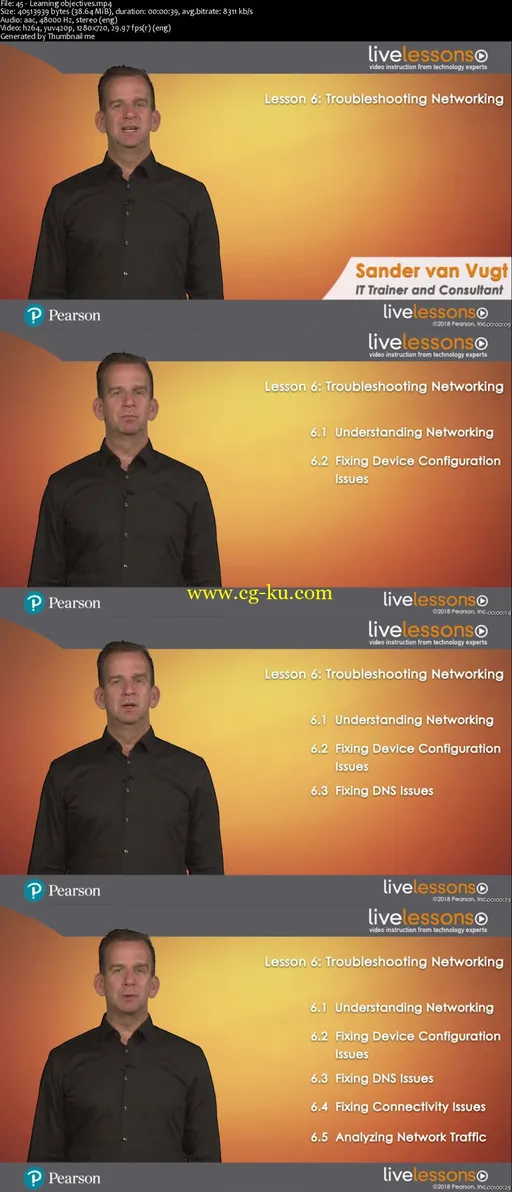
MP4 | Video: AVC 1280x720 | Audio: AAC 48KHz 2ch | Duration: 6.5 Hours | 13.6 GB
Genre: eLearning | Language: English
Introduction
Linux Troubleshooting: Introduction
Module 1: Troubleshooting Basics
Module introduction
Lesson 1: Troubleshooting Basics
Learning objectives
1.1 Understanding Troubleshooting Procedures
1.2 Gathering Information
1.3 Using Red Hat Resources
1.4 Warming Up Lab
Lesson 2: Systems Monitoring
Learning objectives
2.1 Using Monitoring Systems
2.2 Understanding Logging
2.3 Setting up Remote Logging
2.4 Tracking Changes
2.5 Configuring AIDE
2.6 Working with auditd
Module 2: Troubleshooting Boot and Hardware-related Issues
Module introduction
Lesson 3: Troubleshooting Boot Issues
Learning objectives
3.1 Understanding the Boot Procedure
3.2 Understanding Troubleshooting Modes
3.3 Using Low-Level Troubleshooting Modes
3.4 Using Systemd Troubleshooting Modes
3.5 Understanding GRUB
3.6 Fixing Boot Problems on a BIOS System
3.7 Understanding UEFI Boot
3.8 Fixing Boot problems on a UEFI System
3.9 Troubleshooting Failing Services in Systemd
3.10 Resetting the Root Password
Lesson 4: Managing Hardware Issues
Learning objectives
4.1 Understanding Hardware Management
4.2 Identifying Hardware
4.3 Finding Hardware Issues
4.4 Identifying Driver Issues
4.5 Managing Kernel Module Options
4.6 Managing Virtualization Options
4.7 Fixing Virtualization Problems
Lesson 5: Managing Storage Issues
Learning objectives
5.1 Understanding Linux Storage
5.2 Recovering Deleted Partitions
5.3 Fixing File System Corruption
5.4 Dealing with LVM Problems
5.5 Understanding LUKS
5.6 Fixing LUKS Issues
5.7 Fixing Issues with Virtual Machine Storage
5.8 Understanding iSCSI
5.9 Resolving iSCSI Issues
Lesson 6: Troubleshooting Networking
Learning objectives
6.1 Understanding Networking
6.2 Fixing Device Configuration Issues
6.3 Fixing DNS Issues
6.4 Fixing Connectivity Issues
6.5 Analyzing Network Traffic
6.6 Analyzing Local Service Availability
6.7 Analyzing Remote Service Availability
6.8 Understanding Firewalling
6.9 Fixing Firewall Issues
Module 3: Troubleshooting Software-related Issues
Module introduction
Lesson 7: Managing Software Issues
Learning objectives
7.1 Understanding Linux Packages
7.2 Resolving Dependency Issues
7.3 Recovering a Corrupted Package Database
7.4 Identifying Changed Files
Lesson 8: Managing Application Issues
Learning objectives
8.1 Understanding the Application Stack
8.2 Fixing Library Issues
8.3 Debugging Applications
8.4 Identifying Memory Leaks
Lesson 9: Managing Security Issues
Learning objectives
9.1 Understanding Linux Security
9.2 Preventing Backdoors
9.3 Troubleshooting Permissions
9.4 Understanding SELinux Issues
9.5 Managing SELinux Issues
9.6 Understanding PAM
9.7 Managing Authentication Problems
9.8 Understanding Remote Authentication
9.9 Troubleshooting Remote Authentication
Module 4: Troubleshooting Kernel-related Issues
Module introduction
Lesson 10: Troubleshooting Kernel Issues
Learning objectives
10.1 Understanding the Linux Kernel
10.2 Working with Crash Dumps
10.3 Setting up Remote Core Dump Locations
10.4 Testing and Analyzing Core Dumps
Lesson 11: Fixing Performance Problems
Learning objectives
11.1 Understanding Linux Performance
11.2 Fixing Storage Performance
11.3 Fixing File System Performance
11.4 Optimizing Memory performance
11.5 Optimizing Network Performance
11.6 Optimizing Scheduler Performance
11.7 Optimizing CPU Performance
Module 5: Sample Exam
Module introduction
Lesson 12: Sample Exam
Learning objectives
12.1 Fixing Problems Logging in as Root
12.2 Fixing Boot Problems
12.3 Failure to Start SSH
12.4 Analyzing a Hack
12.5 Big Trouble While Booting
12.6 Fixing More Login Problems
Summary
Linux Troubleshooting: Summary



发布日期: 2018-07-06